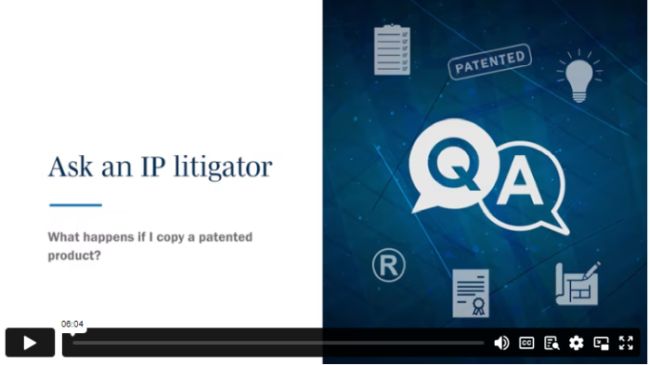Video transcript
Ed Fan (00:05): Let's talk about the patented products and what happens if you infringe a patented product. I'm Ed Fan and I'm here with Niki Mantini, one of Torys' IP litigators, to talk about some of the important considerations for Canadian businesses when navigating patent infringement issues. Niki, say I'm at a company that's developed a fabulous new product for customers, but we just discovered that the product looks a lot like a competitor product.
How do we know if there's a patent problem?
Nicole Mantini (00:29): So, you might be infringing someone's patent rights. And the first thing you're going to want to do is try to figure out if the competing product is the subject of a Canadian patent. First of all, as a reminder, only inventions—not ideas—can be the subject of a patent. And an invention means any new or useful art process, machine manufacturer or composition of matter, or any improvement on any of those things.
Part of the quid pro quo for obtaining a patent in Canada is that you have to disclose your invention to the public. So, pending and issued patents are publicly searchable on the Canadian Intellectual Property Office or CIPO website, generally around 18 months after filing. If you're looking for a patent, you can search by keyword, by patent number, or by owner, and your search will provide the text of the patent as well as basic information about who owns it and when it is expected to expire.
So, the next step, once you've identified some patents of potential interest, is to figure out if your activities are infringing. Patents are territorial. So, a Canadian patent covers activities within Canada and some importation activities in some circumstances, a patent will grant the owner the exclusive privilege and right to make, use, construct and/or sell the subject matter of the invention, the claimed invention.
The invention is going to be defined specifically by the claims found at the end of the patent document, and that raises a related question. Patents tend to be legal technical documents. They're not necessarily easy to interpret. So, Ed, as a patent lawyer and agent yourself, how does one figure out if they're infringing?
Ed Fan (02:02): Well, Niki, as you've noted the scope of a patent is going to be governed by the claims. So even if something is just described in the body of a patent, if it's not in the claims, then it is actually not patented. Patent claims an interpretation varies from jurisdiction to jurisdiction. So here you really have to consider your Canadian situation independently from the situation in any other country.
There are often many claims in a patent, but only a single claim needs to be infringed for it to be actionable, and claim language in a patent is interpreted objectively by identifying the essential elements of the claim. And you don't really look into the intention or the subjective knowledge of whether you think you're infringing or not. In order to have infringement, you have to be copying all of the essential elements of the invention.
If even one essential element is missing, then there's no infringement. But if you are copying all of the essential elements, the fact that you're adding a new feature, that can still be infringement. So, interpreting the scope of a Canadian patent can in many cases require legal advice, especially since, again, your intention and your subjective belief of non-infringement will not matter.
So, Niki, say me and my company or legal advisors are worried that there might be a patent problem. What are the potential consequences of infringement? And how do you deal with it?
Nicole Mantini (03:20): So, the most significant potential legal consequence is that you could get sued for infringement. I note there are some defenses to patent infringement. You might argue that you don't infringe on an interpretation of the claims. You might argue that the patent itself is invalid, and the subject of validity will be discussed in more detail in another session.
But assuming that there's a legitimate claim for patent infringement, if the patentee wins, they can likely get an injunction to stop your infringing activity altogether. They may also be able to get an injunction to stop you from infringing while the litigation is ongoing, although in Canadian law that is significantly more difficult. The patentee could also elect various different remedies for the infringement.
The first is that they can seek their damages, and usually that's in the form of lost sales due to your infringing activities. However, a patentee can also elect to recover your infringing profits instead. Generally speaking, patentees only recover for the time that their patent is valid, but there are some exceptions. For example, they might be entitled to a royalty payment for any infringement that occurs from the time between the publication of the patent and when it's ultimately issued.
They may also be entitled to damages or profits that are incurred after the patent has actually expired. If those damages or profits are related to the infringing activity. In some egregious cases, punitive damages can also be awarded against patent infringers. Often the first step in an infringement proceeding and how you know one may be coming will be the issuance of a demand letter.
And this can present an early opportunity to resolve a dispute, for example, on the basis of a license arrangement or maybe an agreement to stop your infringing activities until a patent has expired. But even before that, you can and probably should if you think you have a patent problem, work with your technical and legal team to see if there is a way to design around or avoid patents of concern, and remember, you just have to avoid one essential element to avoid infringement.
Ed Fan (05:21): So, to sum up, awareness really is the key. It's important to stay on top of the competitive landscape since your intention and knowledge are not a defense to patent infringement. Do research on your closest competitors and understand what patents they may have. Issues around infringement and patent interpretation can be factually and legally complex, so it's also important to get legal advice if you are at all uncertain about whether you have infringing activities.
Especially since remedies for patentees are very broad. Just because your competitor is not commercializing their patent doesn't mean there can be no financial consequences to infringement. So, it's important to stay on top of all these issues.
Protecting your product is of the utmost importance, but what happens if you have developed a product that may be infringing someone else's patent?
In this video, Ed Fan and Niki Mantini share how to navigate issues as a potential infringer. They discuss:
- Assessing a competitor's patent status
- Determining if you are infringing
- Consequences of infringement
Click here to see other videos in this series.
The content of this article is intended to provide a general guide to the subject matter. Specialist advice should be sought about your specific circumstances.



